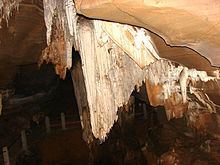 | ||
Cave research, encompassing the study of speleology and biospeleology, is still in its infancy in India. Although there are thousands of caves in India, research expeditions occur in few states. The Siju Cave of state Meghalaya is the first limelighted natural cave from India. Several studies were carried out in this cave in the early 20th century. The Kotumsar Cave of Central India is one of the most explored caves of India, and biologists have classified many types of cavernicoles, i.e. trogloxenes, troglophiles and troglobites, from this cave.
Contents
- Andhra Pradesh
- Chhattisgarh
- Haryana
- Madhya Pradesh
- Meghalaya
- Khasi hills
- Jaintia hills
- Garo Hills
- Uttarakhand
- Cultural importance
- Religious importance
- Current research
- Conservation
- References
The Indian institution mainly engaged in this particular field of research and conversational issues of Indian caves is the Raipur-based National Cave Research and Protection Organisation (founded and headed by Dr Jayant Biswas). The other notable organization is Meghalaya Adventurer Association (founded and managed by Brian Dermot Kharpran Daly) which mainly involved in the caving and cave explorations of the existing caves of the state Meghalaya.
Andhra Pradesh
Chhattisgarh
Haryana
None of these have been studied scientifically yet.
Madhya Pradesh
Meghalaya
The Indian state, Meghalaya is famous for its many caves, which attract tourists not only from India but abroad too. A few of the caves in this region have been listed amongst the longest and deepest in the world.
Khasi hills
Jaintia hills
Garo Hills
Most of the caves of these areas were either discovered or surveyed by the Europeans (especially by German, British and Italian cavers). Herbert Daniel Gebauer, Simon Brooks, Thomas Arbenz and Rosario Ruggieri are the most prominent name among them. Brian Khapran-Daly of Meghalaya Adventure association have expedite most of the caves of Meghalaya (stated above). In addition to these, the cavers' associations of Meghalaya have always been found to be active in cave discoveries of that plateau.
Uttarakhand
and many more scientifically unexplored caves.
Cultural importance
In India, many caves are popular tourist sites. The caves of Ajanta, Udaygiri, Barabar, Sigiriya, Undavalli, Pandavleni, Ellora are famous for archaeological finds and ancient architectural value.
Religious importance
The stalagmite formations present in most natural limestone caves resemble Shiva Linga, a representation of Hindu God Shiva, due to which some of the caves in India are considered of religious import. In addition, several universally known caves related to Buddhism is also exist in India. The same attraction leads local people to visit small caves as it draws tourists to large show caves. In India, Amarnath Temple caves, Vaishno Devi Mandir, Badami Cave Temples, Hulimavu Shiva cave temple, Mahakali Caves, Mandapeshwar Caves, Pandavleni Caves are some of the caves with religious importance.
Current research
Jayant Biswas and his contemporaries continue to research the biospeleology of Meghalaya, Chhattisgarh, Uttarakhand and Western Ghats to establish India amongst other notable countries on the cave map of the world.
Research is also taking place on Indian cave stalagmites, to estimate the past monsoon climate. Dr Ashish Sinha of California State University is taking major steps to understand the past pattern of Indian monsoons via cave research. In addition, Prof. Rengaswamy Ramesh; Dr. M. G. Yadava of Physical Research Laboratory, Ahmedabad; Prof. Bahadur Kotlia of The Durham, Kumaun University Nainital; Dr. Syed Masood Ahmad & Mahjoor A. Lone, CSIR - National Geophysical Research Institute (NGRI), Hyderabad; and Dr. Jayant Biswas, National Cave Research and Protection Organization, India, also initiated some research in this direction.
Besides Dr. Biswas, Prof. G. Marimuthu of Madurai Kamaraj University, Madurai (Chiropterology - study of Bats); Prof. Y. Ranga Reddy Acharya Nagarjuna University (micro Crustacean: Taxonomy); Dr. Daniel Harries of Edinburgh (Cave Biodiversity) and Dr. Adora Thabah of Bristol University (Chiropterology - study of Bats); Prof. R. K. Pradhan Pandit Ravishankar Shukla University of Raipur (Chronobiology); Prof. Ramanathan Baskar Guru Jambheshwar University of Science and Technology, Hisar, Haryana (Cave Geomicrobiology) are some of the known researchers who have tried to shed some light on the Biospeleology (study of organisms that live in caves) of Indian caves.
Conservation
Unscientific quarrying of limestone led to the collapse of the Mawmluh cave of Meghalaya, and the caves of Jantia Hills are also in danger due to excessive quarrying of coal.
The 'National Cave Research and Protection Organization, India' has been formed to help protect the caves of India. In addition, members of the Meghalaya Adventures Association (principally, Brian Kharpan Dally) work to protect the natural caves of Meghalaya.
